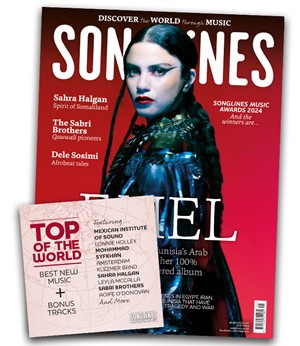Tuesday, July 17, 2018
The Rough Guide to World Music: Nigeria
Nigeria's best-known cultural exports – juju, Afrobeat and fuji music – barely scratch the surface of the vast and vibrant cultural topography of the nation
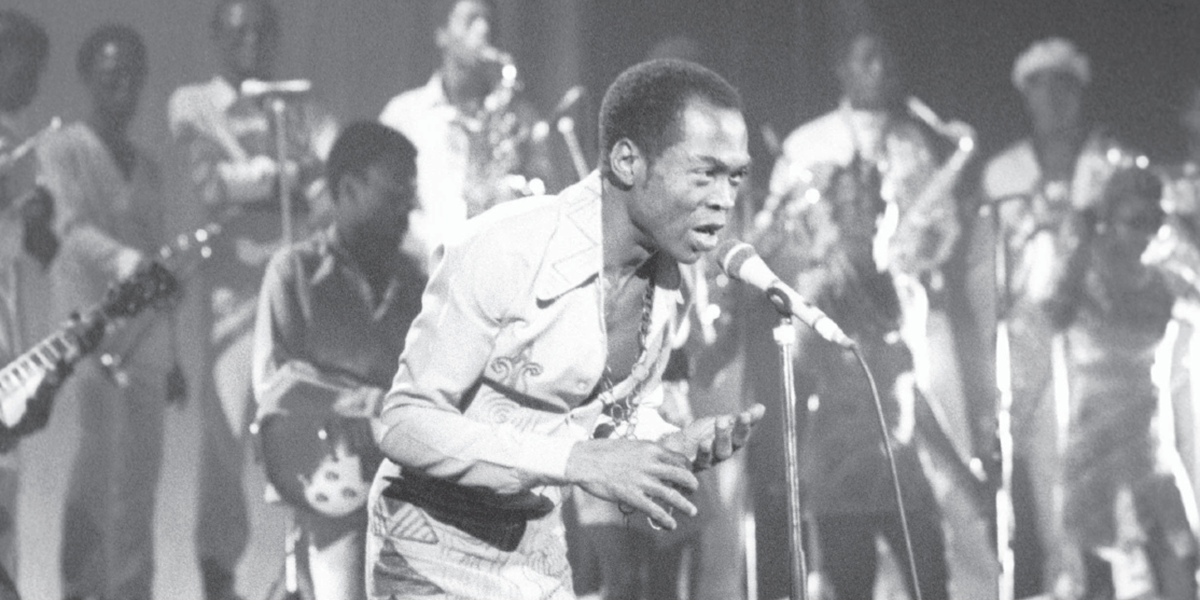
Fela Kuti, an icon of Nigerian music (photo: Ian Dickson / Redferns)
Note that this Rough Guide to World Music article has not been updated since it was originally published. To keep up-to-date with the best new music from around the world, subscribe to Songlines magazine.
With over 140 million people, 250 distinct languages and hundreds of ethnic and sub-ethnic groups, Nigeria is a nation of unique complexity in Africa. Made up of huge, densely populated cities, small villages and rural landscapes, it encompasses the commercial capitals of Lagos and Onitsha, the great seaports of Calabar and Port Harcourt and the ancient city-states of Kano, Sokoto, Oyo, Maidugari and Benin. Its best-known cultural exports – juju, Afrobeat and fuji music – barely scratch the surface of the vast and vibrant cultural topography of the nation. Andrew Frankel begs the reader’s indulgence for the short shrift he gives so many of the worthy styles and genres.
Introduction
In terms of cultural output Nigeria is unrivalled in Africa, with hundreds of studios, thousands of performance venues of all sizes and countless artists and performing groups throughout the country. Yet, excepting its few internationally known African pop icons (Fela Kuti, Sunny Ade and Femi Kuti), the country’s artistry remains a mystery to all but the most ardent adventurers into Nigerian music – those who go to the country, or ply Nigeria’s expatriate market shops in Hackney, Brooklyn, Frankfurt, Milan, Dubai, Singapore and other foreign cities where communities of Nigerians have landed and swelled in the four decades since independence.
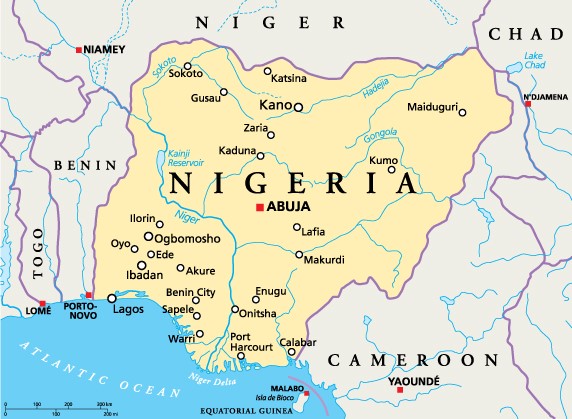
Nigerian Uniqueness
What makes Nigerian music so vast yet so insular? First, with 140 million citizens and growing, Nigeria’s internal population is audience enough to sustain most artistic endeavours, and most artists tailor their music to a domestic audience. Another factor is its relative wealth. Although the trend since the 1980s has been towards eliminating the once enormous middle class in favour of super-rich and super-poor, Nigeria is still an economic giant in Africa, with oil, industrial and trade revenues in multiples of billions. Still another factor is what you might call cultural myopia. Nigeria’s rich cultural heritage is a great source of pride, and Nigerians also have a great sense of the intrinsic worth of their nation, at least in the abstract sense. While any Nigerian will share a grousing session with you about what is wrong with the country (it is a long list), their passion for Nigeria shines through. All this is to say that most Nigerian music is made for the unique tastes of Nigerians.
One principle is consistent throughout all of Nigeria’s forms of musical expression – the power and primacy of words as the formative element of expression. In fact, in many of Nigeria’s cultures, there is no word for music, but rather a variety of highly evolved categories for speech, poetry and metaphor as well as terms for drumming, dance and song. Thus Nigerian music is primarily shaped by the power of words and verbal expression, in both indigenous languages and English, with such concerns as harmony and tuning relegated to a secondary status.
Nigerian Peoples
Nigeria is broadly conceived of in four major regions in alignment with the major ethnic groups. In the north are the Hausa, Fulani and Kanuri, who make up some 29 percent of the population. The Kanuri, descendants of the Kanem Bornu empire (AD 800–1800), and the Hausa, founders of seven great city-states, including Kano (AD 993), Zaria (AD 1000) and Katsina (AD 1100), were until the beginning of the nineteenth century the dominant political powers in what was to become northern Nigeria. But between 1804 and 1808 the previously pastoral and often oppressed Fulani rose under the leadership of Usman Dan Fodio to conquer all of the north of Nigeria and beyond, incorporating it into his vast Sokoto Caliphate, the biggest empire in Africa since the fall of Songhai in the sixteenth century.
In the southwest, the Yoruba and their numerous subgroups make up around 21 percent of the population, traditionally residing in regional city kingdoms such as Ife, Oyo and Ijebu. As with the Hausa and Kanuri, the political geography of the Yoruba was profoundly shaped by Usman Dan Fodio’s campaign, which saw the sacking of numerous kingdoms. The Fulani raids also led to the establishment of the city of Abeokuta (“under a rock”) as a safe refuge for the Egba subgroup, and of a vast refugee settlement called Ibadan, which remains Nigeria’s second-biggest city today. The Egba are famed for their political and artistic achievements – both President Obasanjo and the Kuti family are Egba.
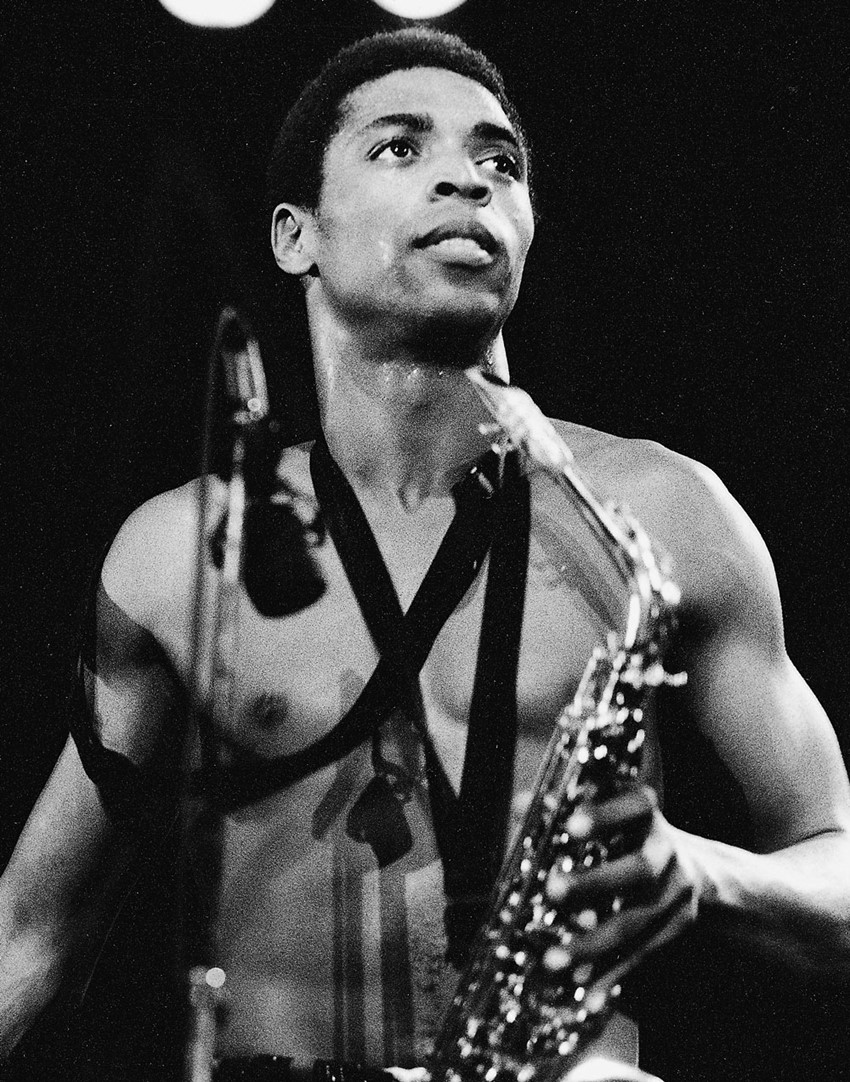
Femi Kuti (photo: Jak Kilbey)
The southeast is home to the Igbo people who make up some 18 percent of the nation. Igbos dominate much of Nigeria’s trade, import and export business, as well as a thriving manufacturing industry specializing in copies of almost anything one might like to buy from car parts to clothing. The major Igbo cities are the trading centres of Onitsha, Aba and Owerri.
The Niger Delta area is increasingly being recognized as a fourth distinct region, both for its importance as the oil-producing centre of the country and for its increasingly prominent civil strife. The region is wildly diverse and includes the Kalabari, Ikwerre, Okrika, Ibani (Bonny and Opobo), Ekpeye, Ogba, Etche, Khana, Gokana, Eleme, Ndoni and Abua peoples, to name a few.
The remaining 35 per cent of Nigeria’s population are found in several diverse but autonomous regions. The Benin people, though related to the Yoruba, are centered on the kingdom and modern city of that name. The Riverine region on the far southeastern edge of Nigeria around the city of Calabar is populated by the Efik, Ejagham and Bekwara peoples. The city of Jos in the Plateau region in the centre of the country was established as a mineral trading camp in the early twentieth century, and has a consequentially diverse regional population. In the Sahelian region north of the Yoruba are the Nupe and a variety of related ethnic groups.
Each of these hundreds of ethnic groups has distinct musical and cultural traditions which it is beyond the scope of this article to describe, so we will limit ourselves to a few of the major trends.
Instruments
The Yoruba people are well known for their elaborate drumming traditions, some of which – along with Yoruba religion – have taken root in Brazil, Cuba, Surinam, the US and elsewhere, where they continue to thrive as living traditions. The heart of Yoruba music is the spoken language. Elaborate language, formulaic speech (metaphors, proverbs and poetry) and a rich tradition of oral history are central to traditional Yoruba cultural identity. Because Yoruba itself is a tone language, the sound contours of formulaic speech (the tonal and rhythmic patterns of commonly used phrases) can be replicated by multiple-pitched instruments in a way that is easily recognizable by any Yoruba speaker. Much, if not all, Yoruba traditional music is built around the spoken language as replicated on instruments.
While Yoruba percussion comes in endless varieties, two common percussion ensembles found widely today are the dundun and the bata. Dundun are hourglass-shaped, variable-pitched instruments with leather tensioning thongs connecting the membranes which cover each end of the hourglass. They come in a wide range of sizes and are played by anything from a solo artist to large sonorous orchestras of over fifty drummers. An iya ilu (mother drum) will establish the rhythm and tempo and all the accompanying drums will pick up complex interlocking rhythms to support the mother drum’s speechifying.
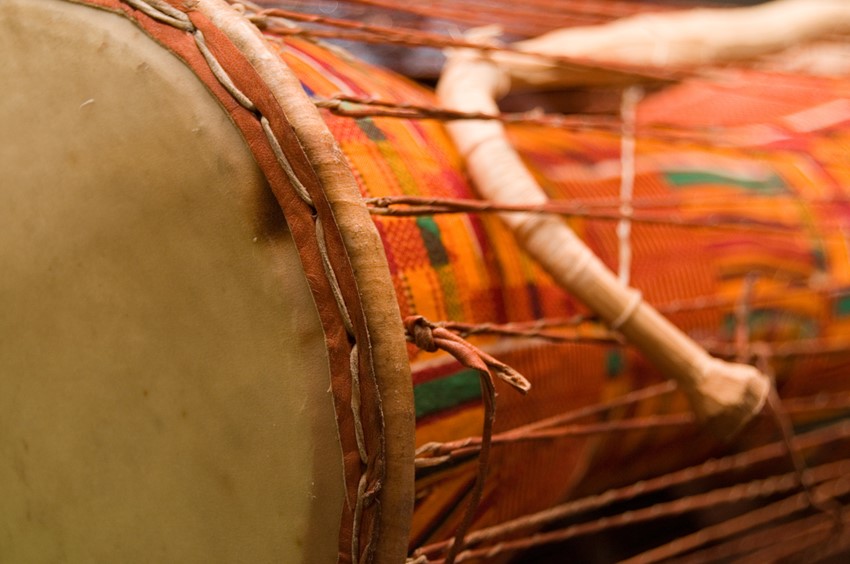
A Yoruba dundun 'talking' drum
Bata are conical-shaped drums with fixed-pitch skins stretched across both heads. The iya ilu bata is worn horizontally across the player’s front. The low-pitched end is played with a hand while the high-pitched end is beaten with a leather strap (bilala). Bata are typically played in ensembles of three or four players, with an iya ilu, a slightly smaller support drum called omele abo and a much smaller set of bata called omele ako and kudi which are bound together in sets of two or three. Bata are traditionally associated with Sango – the Yoruba god of thunder – and are still the drums of choice for many traditional religious practices. Because of this association they have come under fire from Christian and Muslim leaders in Nigeria and have noticeably diminished, though they remain a vibrant tradition. Other Yoruba percussion instruments include bembe, koso, abinti, agogo, shekere and sakara. The musical principles which organize them – interlocking polyrhythmic background with a lead drum speaking – hold true for each of these ensembles, and still define both traditional and pop Yoruba music today.
The Igbo perform in a great array of musical styles, but one commonly found instrument is the ikoro, or slit gong. A log of wood is hollowed out through a narrow slit leaving lips on either end of the slit which can be beaten with a mallet or stick to produce a woody-keyed sound much like a marimba. The ikoro can have many pitches depending on the thickness of the wood in different places along its surface. Because Igbo, like Yoruba, is a tonal language, the ikoro can be used as a “speaking” instrument.
Another common and influential Igbo instrument is the udu pot drum. Like the southern Indian ghatam, it is a resonant ceramic vessel which has a bright staccato pitch when tapped on the side, and a deep resonant boom when the player strikes the open mouth of the vessel.
In the north of Nigeria one finds the string instruments common to the whole West African Sahel, such as the three-stringed lute called molo, and the boat-shaped lute called kontigi by the Hausa (related to the xalam in Senegal and gimbri in Morocco). These are usually played solo as an accompaniment to vocal music, and one of northern Nigeria’s greatest praise singers, Dan Maraya, performs primarily on a kontigi.
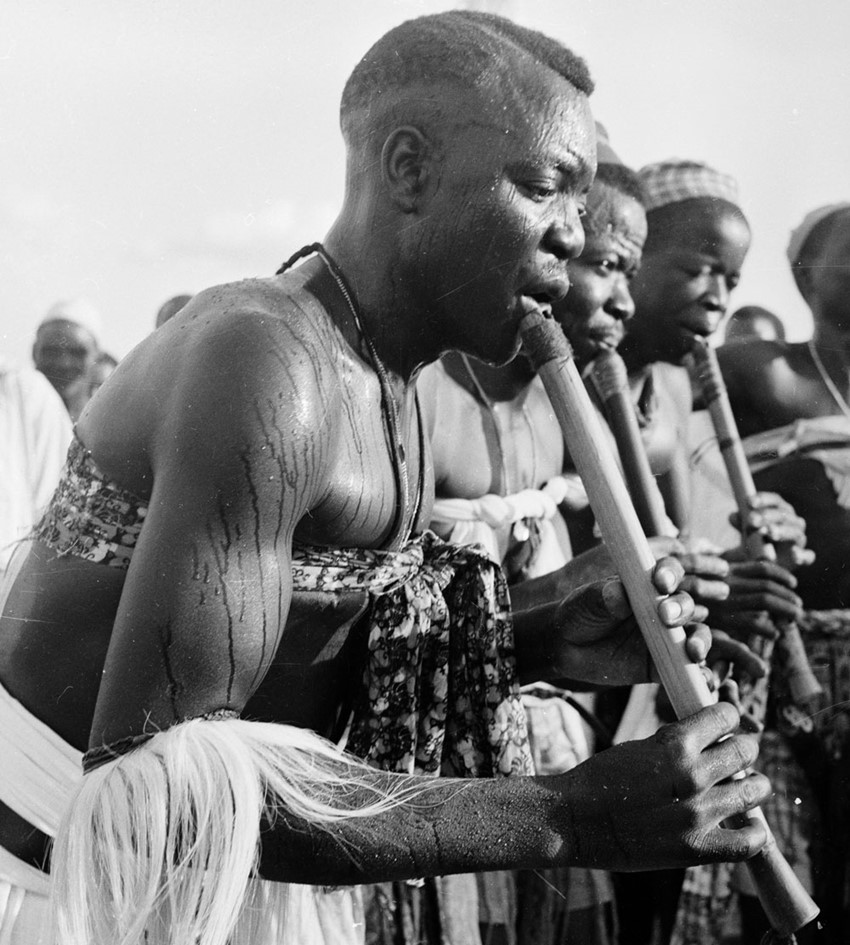
Tiv flautists (Hulton Archive / Getty Images)
Form and function are guided by environment, so in contrast to southern Nigeria, where dense populations and complex social order are expressed musically in large complex musical ensembles, in the rural parts of northern Nigeria where nomadic herders still wander the plains, one finds a variety of portable solo instruments ranging from Jew’s harps to flutes and reed instruments.
In the north’s city-states where emirs still reign, royal arrivals are still announced by the kakaki, a brass trumpet over ten feet long – one of the iconic symbols of the nation. The Hausa and Kanuri also have an hourglass-shaped talking drum (kananngo), of slightly different construction from its southern counterpart, which is played in small ensembles to support courtly praise song.
In Nigeria’s diverse middle states, home to the Ayu, Bada, Cori, Duguri, Eggon, Tiv and many others, there are rich traditions of balafon or xylophone worn around the neck and played polyphonically in ensembles of four or more with the support of gourd rattles.
In the delta region, peoples such as the Isoko and Sekiri have lush-sounding vocal music in which they sing in parallel fourths and fifths (harmonies which sound quite exotic to the Western ear) to the accompaniment of large and deeply resonant drums made from the hollowed stumps of palm trees.
Juju
In Nigeria, even the most contemporary pop music is deeply rooted in tradition, and the most traditional music draws constantly from the popular and contemporary. Yet as coastal trade increased around the turn of the twentieth century and people began to live in multi-ethnic communities, unique urban cultures began to emerge. In Lagos – destined to become Nigeria’s commercial and for a time its political capital – by the 1920s, one could find Nigerians of every ethnicity, as well as a variety of Europeans, Latin Americans and foreign Africans.
In Lagos’s earliest urban neighbourhoods such as Isale Eko, Ebute Meta and Obalende, one could find local and imported alcohol in small social halls such as the palm wine parlours. In these places and at gatherings, city-dwellers would sing contemporary songs derived from folk music styles which reflected their urban experience, accompanied by makeshift rhythm instruments such as a palm wine gourd, a shaker or a glass bottle. Popular stringed instruments such as mandolin and guitar were added, and by the late 1920s juju music had emerged as a Yoruba popular genre. Early pioneers such as Tunde King and Irewolede Denge became some of Nigeria’s first musical stars. By the 1950s popular music was flourishing in a wide range of styles, with Tunde Nightingale, J.O. Araba and C.A. Balogun being the most prominent juju artists.
In the 1950s Nigeria’s (and Africa’s) first broadcast radio station began further to popularize the sounds of Nigerian musicians. Later in the decade, a young carpenter named I.K. Dairo began his rise to stardom, becoming Nigeria’s first international musical star, and the only African musician to receive an MBE. Dairo dominated the social scene of western Nigeria until the 1970s, paving the way for hundreds of other juju bands including Prince Adekunle, Lady Balogun and Moses Olaiya.
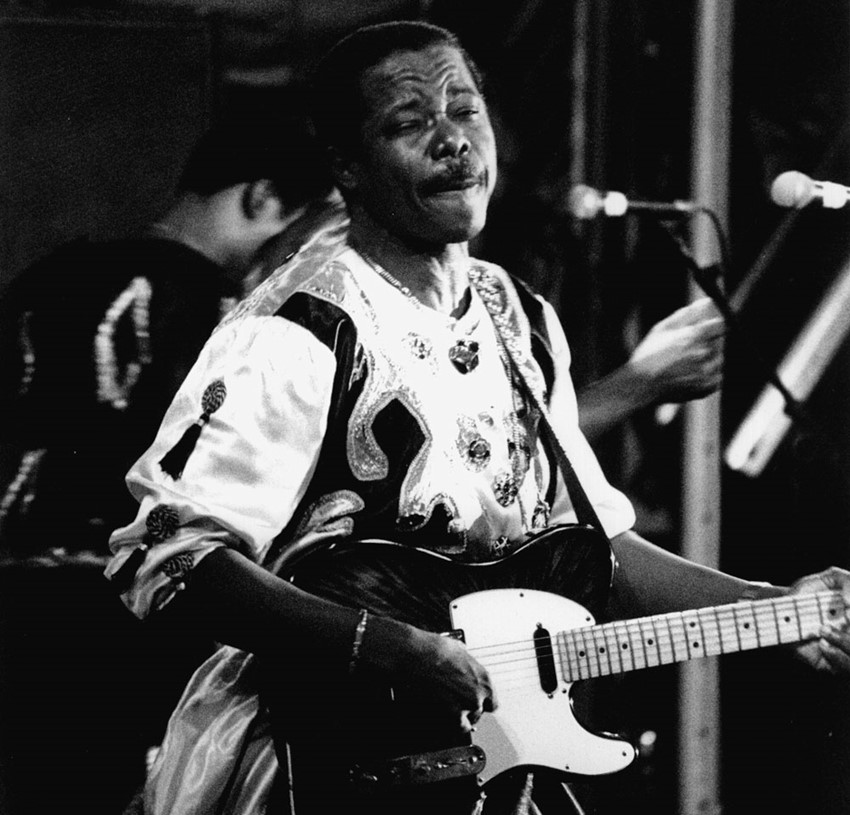
Sunny Ade (photo: Richard Trillo)
In the 1970s, younger upstarts Ebenezer Obey and then Sunny Ade began to achieve popularity, and by 1975 they had finally eclipsed Dairo’s achievements. Throughout the 1970s, 80s and early 90s they battled for dominance of juju music. In 1992, Shina Peters, formerly of the group Shina Adewale (with partner Segun Adewale), rose to prominence on a wave of “Shinamania” as the voice of a new generation with his “Afrojuju” style. For a time Shina was the most popular juju musician, and in the mid-1990s Obey retired from music to pursue a calling as a pastor. However, after a two-year break from 1990 to 1992, King Sunny Ade re-emerged as a major force and has dominated juju music ever since. A new generation of juju musicians, including Dele Taiwo and Paul Dairo (son of I.K. Dairo), cut their teeth in the economically difficult 1990s but failed to gain the international prominence of their predecessors. By 2000, juju music had ceased to be Nigeria’s favourite pop genre and for the youth of today it is considered more of a historical sound. Fortunately for Nigeria’s few remaining juju icons, the political and business leaders of the nation were raised on their music, so they remain popular and heavily patronized by Nigeria’s modern elites, with little competition. After a recording hiatus of almost ten years, King Sunny Ade released Divine Shield (his 113th record) in Nigeria in December 2004.
Highlife Nigeria Style
Widely credited as having evolved in Ghana, highlife was the dancehall music of Africa’s emerging elites, whose new, modern “high” style of living inspired the name. Though Ghana took the lead, Nigeria was never far behind in embracing the genre as its own. Many early highlife bands emerged from military and police marching bands, where musicians could get access to hard-to-find and expensive instruments, but the broad popularity of highlife, combined with a growing middle class, quickly gave rise to a class of professional highlife musicians.
By the 1950s, stars such as Bobby Benson, Cardinal Rex Lawson, Roy Chicago, Victor Uwaifo (now Minister of Culture of Benin), Ambrose Campbell and Dr Victor Olaiya (the “evil genius of highlife”) were in constant demand, and their records were enjoyed widely alongside those by Ghanaian highlife icons like E.T. Mensah. Highlife was performed and enjoyed across ethnic lines, by Igbo, Hausa and Yoruba alike. Fifties highlife, taking its inspiration from the Ghanaian style and from American jazz, was fuelled largely by brass and wind instruments, with a percussive rhythm section driving the dance rhythms. This was goodtime music in an era of growing prosperity.
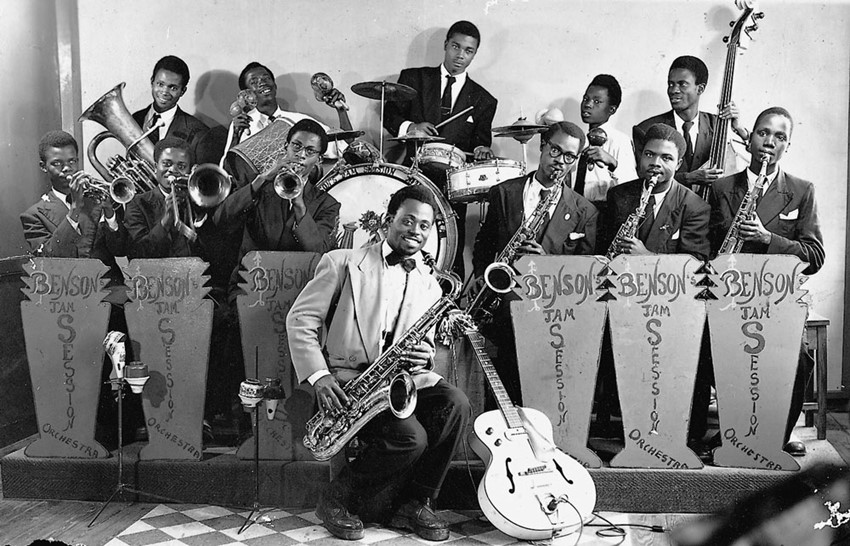
Danceband Highlife with Bobby Benson (photo: Graeme Ewens Collection)
In eastern Nigeria, Igbo and Efik bandleaders expanded the role of guitars and blended a new brand of guitar highlife uniquely their own. Early bandleaders like Stephen Amechi, Zeal Onyiya, Celestine Ukwu and the Peacocks International inspired a generation of youths in the 1960s to make guitar-style highlife – with its twangy interlocking guitar lines and punchy horn refrains – their own, transforming it from music of the elites to that of the people. Stars such as Stephen Osita Osadebe, Inyang Nta Henshaw, Peter Effiom and Mike Ejeagha arose in this era.
Sadly, the upward trajectory of highlife in Nigeria was badly hampered by the Nigerian civil war which devastated eastern Nigeria from 1967 to 1970. Ethnic tensions during and following the war undermined the national potential of Igbo music as Igbos were vilified in western and northern Nigeria. More devastating still, the Biafran economy and most of its frail infrastructure collapsed.
Healing came quickly, and by the mid-1970s a whole new crop of highlife musicians emerged. Stephen Osita Osadebe, who had started his career in the 1960s, re-emerged and remains the leader in Igbo highlife today. Bands and singers such as Oriental Brothers, Oliver deCoque and Ali Chukwuma rose to prominence as they re-engineered Igbo highlife to be more guitar-based, with longer, evolving arrangements, and dug deeper into the indigenous culture, making it more Igbo cultural music than modern urban social music. Other popular bands included The Nkengas, actually the defecting band of Chief Stephen Osadebe, whose seminal Live In London is still considered one of the great recordings of Nigerian highlife.
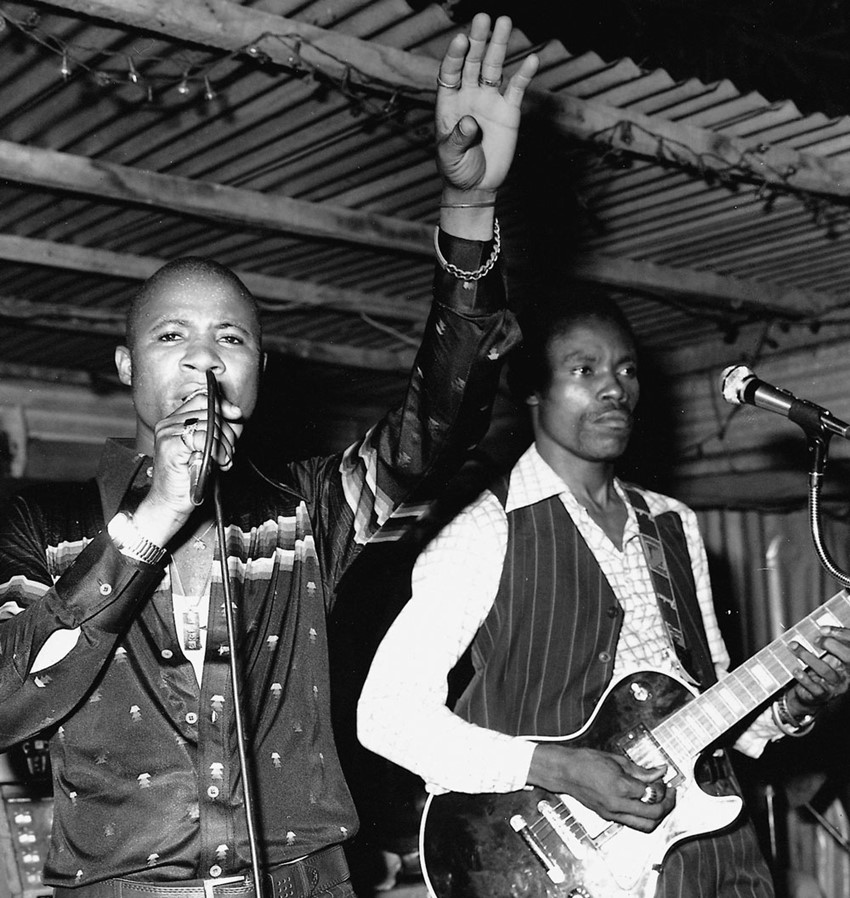
Dr (Sir) Warrior & Oriental Brothers (photo: Graeme Ewens Collection)
Today, highlife in Nigeria primarily enjoys the status of classic pop music, yet several prominent highlife artists remain on the scene. In addition to Osadebe and Oliver deCoque and his Ogene Super Band, there is Onyeka Onwenu, one of Nigeria’s leading female artists. In recent years her music has taken on a gospel tinge. Of the younger generation, Sunny Neji is probably the leader of the pack. Starting his career as a backing singer in Onyeka’s band, he writes and performs highlife-influenced pop music which also weaves in elements of Congolese music, funk, pop, juju and more. His 1997 album Mr Fantastik propelled him into the limelight, and his 2003 album Unchained also enjoyed wide success, particularly the hit love song “Oruka”.
Traditional Pop and Apala
A wide range of music is performed, recorded and released in Nigeria each year in the realm of what can only be called “traditional pop” – music based directly on a traditional music style but performed in a popular format or by a musician seeking to achieve notoriety. Examples include the Egedeege cultural ensemble from eastern Nigeria and Show Promoter and his band from Imo state. By far the most dramatic kind is Yorubaapala, a traditional form of social music from the Ijebu region of Yorubaland in what is today Ogun state. The ensemble for apala music is led by a set of hourglass-shaped talking drums called gangan or adama, accompanied by agogo bells, shekere (gourd rattle), acuba or ogido (a local relative of the conga drum), maracas, wood block or claves, and call-and-response backing vocalists. The resulting rich and surprisingly melodic web of sound grooves and pulses like nothing else.
In the 1960s, two apala singers performing traditional music at traditional events and recording traditional songs, Haruna Ishola and to a lesser degree Ayinla Omowura, became major pop figures in Nigeria. Their respective record companies positioned them as competitors for the same market, fuelling their rising popularity and the interest of the Nigerian paparazzi.
Sadly, both singers died in the early 1970s, Ishola of natural causes and Omowura from injuries sustained in a bar-room brawl. For almost thirty years no other apala singer achieved their level of notoriety, as the genre made way for fuji and other forms of percussion-based music. Then suddenly, in 2003, Museliu Ishola, one of Haruna’s sons, burst onto the national music scene with an updated apala music which remarkably retained all the richness and intensity of the original, while adding occasional drum machines and rappers to bring it into the twenty-first century. Since then, fans young and old have rallied to the apala sound once again.
Fuji Fever
Despite some similarities, fuji music does not have its roots in apala music, but rather is based in the Islamic communities of Nigeria’s Yoruba people.
Islam predates Christianity in Nigeria by some centuries, but until Usman Dan Fodio’s military campaign in the nineteenth century it was found primarily in the great city-states of the north. So the religion is a relative newcomer to the Yoruba, and as with Christianity the primarily orisha-worshipping Yoruba have taken and “Yorubanized” it. The celebration of Ramadhan was, by the mid-twentieth century, a major event in Lagos. A tradition evolved in which groups of young men would traverse the Muslim neighbourhoods singing improvised music to the accompaniment of pots, pans, drums, bells and whatever else was available, to wake the believers by 5am for morning prayer. This tradition came to be called ajisaari, or wéré, and by the 1970s was so widespread that individual ajisaari singers began to achieve notoriety.
In 1966, I.K. Dairo and Haruna Ishola sponsored a competition among Lagos’s ajisaari singers. A young man name Sikiru Ayinde Barrister emerged victorious with a recording opportunity. It was Barrister who, by his second recording, gave the music the name fuji, attributed by various urban legends to Fuji tinned mackerel, the elaborate and classical structure of the music (as in fugue) or Japan’s Mount Fuji. A competitor quickly arose to galvanize fuji fans into two camps: Kollington Ayinla crowned himself “Baba Alatika”, father of the common man. Whereas Barrister delved into broad social commentary with a comical bent, Kollington focused more on spiritual issues, enemies and other more traditional themes. Barrister evolved his makeshift band to include a range of talking drums, shakers, bells and a chorus. Kollington added bata drums to his music, calling it bata fuji.
By 1985, there were dozens of fuji artists. Fuji is often contrasted with juju, and in general this is apt. Juju is guitar-based, fuji percussion-based. Juju is predominantly Christian-oriented music, and fuji primarily Islam-oriented. Juju patrons are the educated upwardly mobile, whereas fuji patrons are the poor. However, both are strongly rooted in the Yoruba traditions of patronage and praise singing, and both wax philosophical about social issues, politics and more.
By the late 1990s, fuji was beginning to overtake juju as Nigeria’s number-one popular music. Because of its Islamic bent, it found a wider audience in the non-Yoruba north, and had a bigger potential audience as economic pressures created fewer haves and more have-nots. Most importantly, all that was required to start a fuji band was a singer and some local percussion. By the 1990s, every city, town and village was brimming with aspiring local fuji players, while the capital required to acquire a guitar and other Western instruments had caused juju and highlife to diminish measurably.
While Kollington and Barrister have remained the titans of fuji, another singer has emerged to become the clear leader and innovator. Wasiu Ayinde Barrister was a backing singer in Barrister’s band before going solo. With an innate sense of popular trends and a magnetic personality, Wasiu stormed the fuji world in 1984 with his innovative Talazo Disco. Over the past two decades Wasiu, now known as KWAM (King Wasiu Ayinde Marshall), has outstripped all competitors. Other popular figures include Adewale Ayuba, who rose to fame, then moved to the US to spend a decade in Brooklyn, only to return eventually to Nigeria to rebuild his fan base. Abass Akande Obesere was fuji’s answer to the youth’s desire for a bawdy, urban icon, and remains a popular force.
As fuji musicians have sought to evolve they have moved in some surprising directions. With the addition of horns, keyboards and even guitars at times, their music has come to sound juju-like. Obesere distinguished himself by using drum machines in a land where brilliant percussionists are abundant. Simultaneously juju, in response to fuji’s popularity, has become more percussive and fuji-like. However they evolve, the two styles remain distinctly Nigerian, appealing broadly to Nigerians at home and abroad, while being almost completely overlooked by the rest of the world.
Waka
Concurrent with fuji’s rise was the ascendance of waka music. Similar to fuji, waka is vocally oriented music backed by a percussion orchestra of Yoruba talking drums and hand percussion. The major distinction between the two is that waka’s stars are women. Like fuji, waka’s artists tend to be Muslims, and its audience largely the Muslim middle and lower classes; the title Alhaja borne by so many waka divas shows they have participated in the Hajj, the religious pilgrimage to Mecca. Notable among scores of waka singers are Alhaja Asanat Ejire Omo Aje and Alhaja Chief Batile Alake. However, the undisputed queen of waka (and an under-appreciated ambassador of Nigerian music in general) is Queen Salawa Abeni, whose career spans almost three decades. For a time in the 1980s, she was inseparable from fuji innovator Kollington Ayinla, even sharing a backing band with him, though by the 1990s the two had gone their separate ways. Nigeria’s leading woman of song, Salawa has done much to secure a respected role for women as singers of popular and praise music. She boasts dozens of records and a broad international following, which she fosters with regular tours to Europe and the US.
Fela Kuti and Afrobeat
Probably the best-known icon and the largest musical personality from Nigeria was Fela Anikulapo Kuti. Born in the city of Abeokuta, Fela was the child of a Western-educated minister father and a social activist mother. When he was sent off to London to study at Trinity College, he shifted his studies from medicine to music. On a visit to Los Angeles in 1966, he was deeply influenced by the Black Power movement. Returning to Nigeria, he formed his first group, the Koola Lobitos, who played a hybrid of jazz and highlife with modest success in Lagos.
In the late 1960s, Lagos was a focus of musical experimentation, with jazz, funk and African music vying to dominate a booming social scene which included I.K. Dairo’s juju, Orlando Julius’s Super Afro Soul, Geraldo Pino’s James Brown renditions (see Sierra Leone chapter), Bobby Benson’s highlife and more. It was in this cauldron that Fela began to evolve his music, combining a love of jazz, funk, traditional music and ritual with his social activism, black consciousness and outrageous showmanship to produce a unique style which he dubbed Afrobeat.
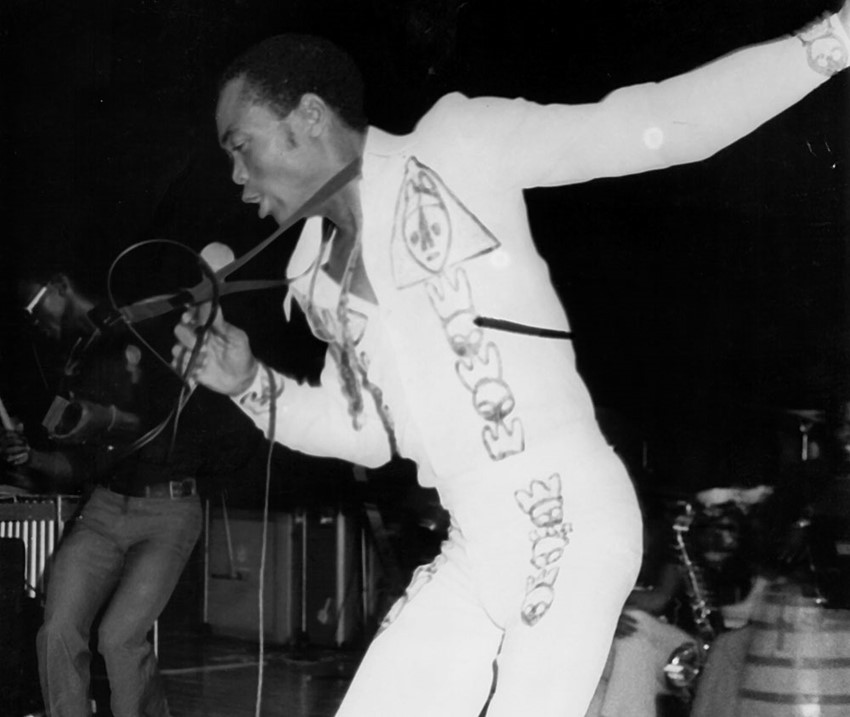
Fela Kuti (photo: Graeme Ewens Collection)
Fela declared his compound an independent republic, and was continually pushing the bounds of social and political rebellion in what is generally a socially and politically conservative country. He antagonized the police, the army and the federal government, and it was no surprise when he was jailed from 1983 to 1986. Once he emerged his audience had largely moved on, and the combined forces of a crumbling economy and an oppressive government undermined the impact of his powerful social message. Though he remained an important figure until his death in 1997, he was never able to regain the intensity of his pre-prison days.
During his life, no musician other than his eldest son Femi dared try to compete with Fela in the style of Afrobeat. But like an African Johnny Appleseed, after his death a veritable sea of Afrobeat and Afrobeat-influenced artists rose up to fill the void. Nigeria now boasts dozens of Afrobeat outfits, with straight Afrobeat, Afrobeat-rap, Afro-jazz, Afro soul and more.
In the realm of pure Afrobeat, Femi leads the pack, both at home and abroad, performing at his New African Shrine as often as three nights a week to a growing crowd of regular fans. However, many Nigerians feel that younger brother Seun Kuti, who is backed by much of Fela’s original Egypt 80 band, is the real heir to Fela’s look, style and sound. Fela’s longtime friend and collaborator Dede Mabiaku also performs a remarkably Fela-like brand of Afrobeat and has a steady following. And there are many lesser-known artists, such as Baba 2010, Alariwo of Africa, Korikima and Amala. Outside of Femi’s New African Shrine, there are no specific Afrobeat venues in Lagos, but the wide range of hotels, nightspots, cultural centres and festivals feature live music.
Even more impressive is the impact Afrobeat has had on a global scale (see box overleaf), from the horn-driven sounds of New York favourites Antibalas to the Afrobeat hip-hop of London’s Weird MC. Fela’s life’s work has transcended that of a mere man. As aptly described by the artist Lágbájá in his song “Abami”, Fela has entered the realm of the divine and become an orisha, a deity, and the ripples of his legacy continue to spread.
Praise Singing the Big Boss
In the past two decades, as the Nigerian economy has gone from bad to worse, the attendance at formal religious ceremonies has swelled dramatically. Houses of worship have sprung up in homes, in fields and in the decaying hulks of abandoned industrial complexes; they are literally everywhere. On the last Friday of each month, two million Nigerians convene in a field between the commercial capital of Lagos and the second-largest city of Ibadan to hold – under the title of the Redeemed Christian Church of God, commonly called Redeem Camp – the largest church service on the planet. Religion has become a major force in the social, cultural and economic life of the nation. This in turn has had a major impact on the music industry.
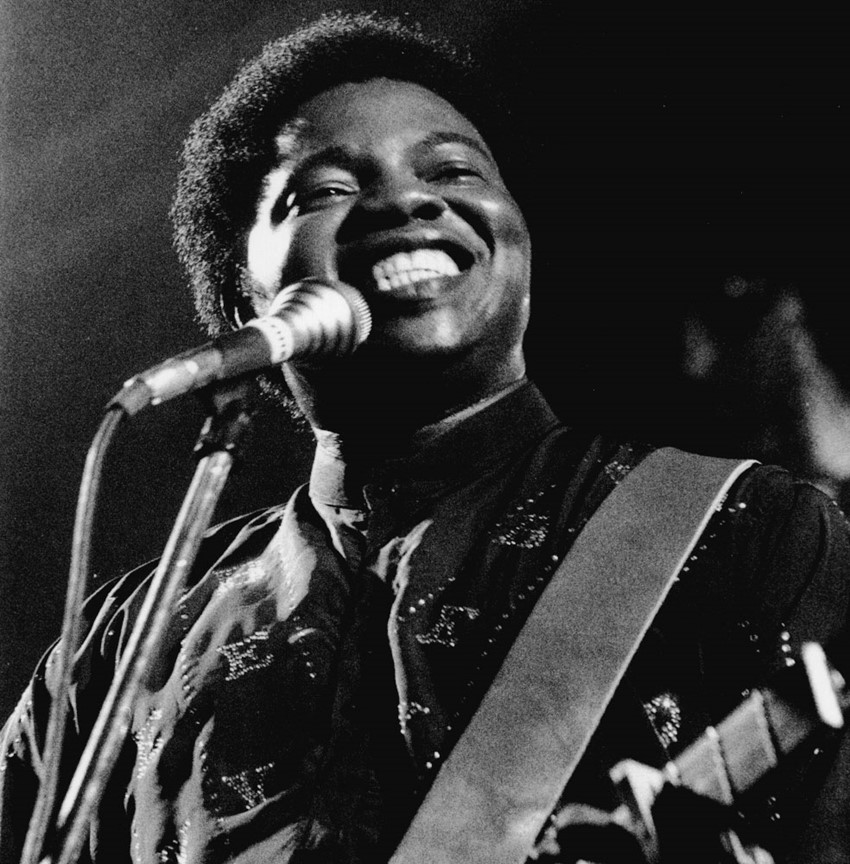
Ebenezer Obey (photo: Jak Kilbey)
Churches in Nigeria have always boasted music, and by the 1970s musicians had begun to emerge from the church movement. Popular groups such as the CAC (Christ Apostolic Church) Good Women’s Choir made a strong regional impact as recording and performing ensembles. Over the 1970s, 80s and 90s, icons such as I.K. Dairo, Sunny Okosun and Ebenezer Obey traded in their guitars for sceptres and became leaders in their own church movements. By the 1980s, when Timi Osukoya had his hit record Divine Assurance, religious music had begun to emerge as popular music. As piracy, security issues and economic problems have eroded opportunities in the music business over the past two decades, new opportunities for a career as a gospel musician – with a growing audience, paid work as a sideman and access to instruments and studios – have increasingly opened up.
Nigerian gospel sounds little like its American namesake, encompassing a wide range of musical expression. In many church movements, particularly the smaller ones, the music has much in common with local folk styles, adapting widely available traditional instruments and local vocal traditions. In the larger and more affluent churches, one finds guitars, drums, organs, choirs and more.
Popular Lagos musicians have been heard to complain that the best backing musicians have been gobbled up by the churches. Nigeria’s most successful gospel stars have absorbed many of the influences of Western soul and gospel music, and cross-pollinated them with indigenous rhythms and grooves.
Both Sunny Okosun and Onyeka Onwenu had successful careers in highlife before succeeding as gospel singers. Buchi Atuwonuwu, Kunle Ajayi, Chuks Ofojebe, Faladey, Folake Umosen and Ben Okafor are among the many highly successful gospel artists. Then there are the hybrid sounds such as gospel-reggae (Christafari), gospel-jazz (Soji Enigbokan) and gospel-hip-hop (Lex and Lekanskills).
With their direct access to a vast market, the backing of powerful churches and the widely sought positive messages they are putting forward, gospel artists are currently enjoying support and opportunities that other artists can only dream of.
Reggae, Hip-Hop, Rap and Beyond
Reggae has been an important genre in Nigeria ever since Bob Marley conquered the world in the 1970s. Among Nigeria’s top artists are Ras Kimono, Blakky, Evi-Edna Ogholi and Orits Williki, though none have achieved the heights of popularity and the brief flicker of international acclaim of Majek Fashek. His 1990 album Prisoner Of Conscience and 1991’s Spirit Of Love received rave reviews at home and abroad. Many thought Majek’s success would open the door for other Nigerian artists, but that was not to be, and personal difficulties on the road, on stage and in the studio scuttled his great trajectory. Though he remains popular and active in both the US and Nigeria, neither he nor any other Nigerian reggae artist has been able to match the international notoriety he brushed up against in the 1990s.
Hip-hop began to gain popularity in Nigeria in the mid-1990s, though it was not until the end of that decade that any domestic rappers began to be taken seriously. The initial success of The Remedies was probably the catalyst. Formed in 1997, the group released two songs, “Judile” and “Sakomo”, which became overnight hits in Nigeria. Though The Remedies lasted only three years, its three founders showed the way for the serious exploration of hip-hop and rap in Nigeria. Tony Tetuila reshaped his career as a pop/soul singer and is still enjoying wide popularity. Eddy Remedy continued with rap, and – probably the most popular and certainly the most controversial – Idris Abdulkareem wears the self-proclaimed title of “Nigeria’s greatest rapper”.
Much of the early Nigerian rap was ragga-style with a heavy Jamaican influence, but by 2001 every kind of indigenous Nigerian music had begun to cross-pollinate with rap and hip-hop styles. By 2004, groups like the Trybesman, Plantashun Boyz, B.A.N.T.U. and Ruggedman had broadened the field and its popularity.
The strong relationship between Nigeria and the UK has made Nigerian rap into an international genre. Rappers based in London enjoy success as Nigerian homeys, while those based in Nigeria have strong followings among British-Nigerian youth. This was demonstrated when the UK-based JJC and the 419 Squad won the 2004 Kora award for Best African Group in Johannesburg. To further underscore the ascendancy of African rap, when MTV recently launched its hundredth channel, MTV Africa, broadcasting to 48 countries, they did so with simultaneous concerts in Abuja (Nigeria) and South Africa. The Nigerian concert was headlined by Ludacris, supported by JJC and the 419 Squad and rising star 2Face Idibia, who became the first Nigerian rapper to have his video broadcast on MTV.
While contemporary Nigerian rap is obviously aimed at an international audience, it is also clearly rooted in Nigerian culture. With song titles and vernacular that regularly delve into pidgin English and local languages, the tinny production which is the hallmark of most contemporary Nigerian studios, and themes which clearly speak to a global Nigerian audience, these artists have a foot in two worlds. For once, it appears that the world may be poised to reach out and embrace them as they are. Only time will tell.
Some of Nigeria’s best talents have forged new styles and genres which don’t fit any category or norm. A classic example of this is Prince Nico Mbarga whose “Sweet Mother” (1976) is one of the biggest hits in African music history. Combining the influences of Cameroonian makossa with Igbo highlife and a little bit of rock ’n’ roll, Prince Nico and his band Rocafil Jazz defined a new style and sound which remain unique to this day.
Today, new artists are evolving their own individual sounds in urban Nigeria. Daddy Showkey is an outstanding example. Born and raised in Lagos’s infamously rough Ajegunle quarter, Showkey naturally absorbed a wide range of culture and lots of street smarts. In Ajegunle and many of Lagos’s rougher neighbourhoods the streets are run by “area-boys” – tough street thugs who control business by extorting protection money, run petty street scams, provide or revoke security and generally terrorize the residents.
Daddy Showkey evolved a stage persona which is simultaneously homage to and caricature of the area-boys, adorning his stage line-up with dancing muscle-bound area-boys as well as the more typical female backing singers. His music draws equally from reggae, soca, highlife and a wide range of Nigerian influences. Other musicians such as the popular Baba Fryo have followed in this direction.
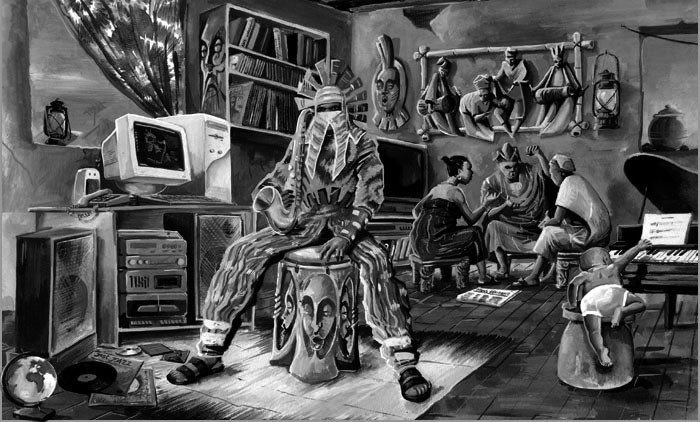
Lágbájá, the masked artist
Another remarkable artist is the man known simply as Lágbájá, which in Yoruba means the equivalent of “somebody, anybody or everybody”. Lágbájá, who wears a mask to conceal his true identity, is the faceless voice of the masses, the social conscience of the so-called “common man”. Lágbájá emerged during the tyrannical rule of despot Sanni Abacha, at first to a mixed response. However, by 1995, when he released his first cassette, his unique musical blend, socially incisive and sometimes satirical lyrics and upbeat stage shows had propelled him to broad popularity, and by the late 1990s he had become one of Nigeria’s top artists. Lágbájá combines influences of juju, Afrobeat and highlife with R&B, pop, funk, soul and hip-hop. His influence in Africa extends far beyond the borders of Nigeria and this is an artist to watch.
Future Grooves
What lies in the future for Nigeria’s music scene? The lack of a music industry poses a real challenge for some of the nation’s budding talents, and such gifted singers as Sammy Needle Odeh and Yinka Daves struggle to build business opportunities which match their skills. There is no lack of talent in any Nigerian genre, only a drought of opportunity and reward. If, one day, Nigeria truly begins the long and challenging resurrection so many hope for, and can sustain a business environment where intellectual property is respected, where the general public feels safe to go out at night, where spendable income makes it possible for the common man to patronize the arts and where industry makes those arts accessible to its citizens, then Nigeria will once again be among the giants of the world in musical and overall artistic achievement.

